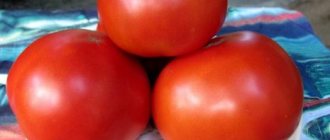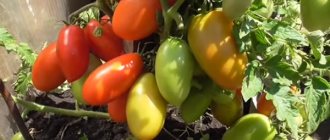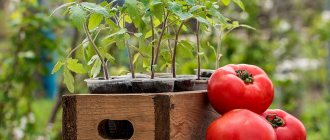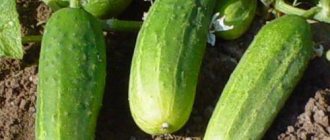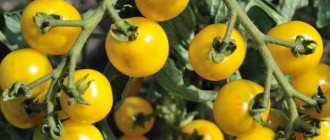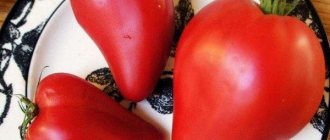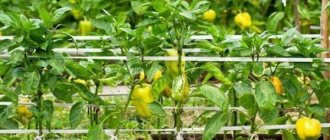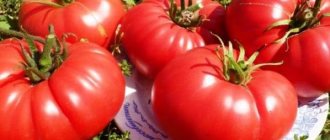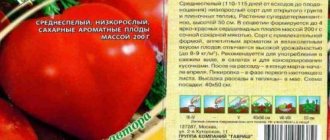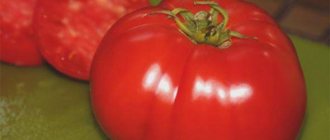| Ripening period: | early |
| Shape, weight of fruits: | cone-shaped, 45-60 gr. |
| Productivity: | 1.8-2.5 kg per sq. m. |
| Growing regions: | Northern, Central, Volgo-Vyatka |
Dwarf pepper Winnie the Pooh is intended for those vegetable growers who want to get an early harvest of their own. Due to its compact size, it can be grown not only on the street or in a greenhouse, but also at home: on a balcony, loggia or even on a windowsill. The plants will not take up much space and will delight you with miniature, tasty fruits. The variety has become popular among gardeners due to its ease of care, early ripening and disease resistance.
general characteristics
The Winnie the Pooh pepper variety is included in the State Register of the Russian Federation and is approved for cultivation in the Central, Northern and Volga-Vyatka regions.
It was included in the list of breeding achievements in 1981, after which it became widespread throughout Russia. On average, the cultivar bears fruit after 110 days. The countdown is traditionally carried out from the moment the seedlings emerge. Pepper is able to fully ripen in open beds even in unfavorable climatic conditions typical of northern regions.
The plant is compact and therefore suitable for dense planting.
The description of the variety states that the pepper bush is standard and determinate. This means that the cultivar has a powerful stem that can support the weight of its fruits and does not need gartering or pinching the top.
Winnie the Pooh stops growing when he reaches a height of 25-30 cm. Such characteristics of the variety make it interesting for people who do not have land and want to get their own vegetables at home.
Pepper is distinguished by a bouquet (bunch) type of fruiting; the ovaries are formed in the area of the crown of the stem. Each bush bears up to 8 fruits per season.
Vegetables can be picked from plants and eaten already at the stage of technical ripeness. During this period, the peppers have a light green color. When fully ripe, the color changes to red (see photo).
Despite the compactness of the conical fruits (on average 50 grams), peppers have a fleshy wall, the thickness of which can reach up to 8 mm.
Ripe vegetables have tender, juicy pulp with a pronounced peppery aroma.
The variety is suitable for whole-fruit canning, stuffing, salads and fresh consumption.
Features of care
Seedlings are moved to a permanent place of growth at the age of 60-70 days. When planting, please note that Winnie the Pooh loves light, fertile soils with a pH of 6-6.5.
The recommended arrangement of bushes is 50 by 35 cm. The variety is suitable for thickened planting, per 1 sq. m you can place from 8 to 12 bushes.
The cultivar is interesting for growing due to its low maintenance requirements. It has no stepsons, it does not need shaping: pinching the top and removing side shoots. However, some gardeners stubbornly remove the top shoot of this variety, as a result they lose half the harvest.
Caring for peppers comes down to traditional measures: regular moistening, removing weeds and providing aeration to allow air to reach the roots.
Peppers need to be watered at intervals of 3 days, loosen the soil after each watering and weed. To avoid the last two procedures, when growing in greenhouses, many gardeners practice mulching the soil with hay or straw.
How to plant seedlings in open ground?
Seedlings should be planted in the ground in June, on a cloudy day or in the evening. The planting period lasts from May to mid-June. If the pepper will grow in a greenhouse, then this can be done in April.
Before sowing in the ground, the seeds are disinfected in a 1% solution of potassium permanganate for 30 minutes. Next, they are washed with water and treated with growth stimulants. They must also be treated with antifungal drugs to protect future seedlings from fungal infection.
There should be a distance of up to 60 cm between the holes, and 60 cm between the ridges. After planting, the seedlings are covered with film. This will speed up the start of growth. In the first weeks the plant will look a little wilted. But there is no need to be afraid of this. It will take the necessary form on its own.
An excellent choice of planting location would be the bed where beans, peas, cabbage and carrots previously grew. The plant is not friendly with tomatoes, eggplants, and potatoes. Therefore, it is better not to devote the places where these vegetables were grown to peppers.
The fruits ripen very quickly. The entire harvest can be harvested in 2-3 harvests. Next, the plants are removed.
Advantages and disadvantages
Winnie the Pooh sweet pepper is loved by many farmers who do not grow the crop in large quantities for the following advantages of the variety:
- early fruiting;
- possibility of dense planting;
- stable yield throughout the season;
- good taste;
- attractive presentation;
- ease of care;
- resistance to diseases and pests;
- can be grown at home.
Among the disadvantages, gardeners in their reviews highlight relatively low yields due to the small size of the fruits. However, with thickened planting and application of fertilizers, the indicators can be increased by 2 times.
Sweet pepper disease
The most common disease of sweet peppers is late blight. It appears as dark spots with a green outline on leaves, stems and fruits. If measures are not immediately taken to stop the disease, it will subsequently lead to rotting of the fruit. Late blight is a common disease of tomatoes, so sweet peppers are not recommended to be planted after or next to tomatoes. The disease occurs due to a sharp decrease and increase in temperature, as well as high humidity. The disease often affects plants in greenhouses when the temperature regime is not observed. When the first symptoms of the disease appear, spraying with Bordeaux mixture will help get rid of late blight.
Similar varieties
In addition to the Winnie the Pooh pepper, gardeners identify several more varieties that are similar in description and characteristics:
- Red chanterelle;
- Kuban canning;
- Irina;
- Dwarf;
- Sturdy.
Red chanterelle is an early variety that produces a harvest on the 110th day after mass germination of seedlings. It stands out for its juicy, sweet, miniature fruits weighing no more than 30 grams. Peppers are decorative. This means that it can be placed not only in beds, but also in pots, grown at home. The variety is ideal for whole-fruit canning.
Kuban canned pepper – pepper with a ripening period (110-120 days). The average fruit weight is from 70 to 90 grams. When fully ripe, vegetables are dark red in color, thick-walled, juicy and sweet. At the same time, the skin of peppers is thin and tender. On average, the height of the bush is 35 cm, but can reach up to 0.45 m.
Irina produces fruits after 100-110 days, which are counted from the moment the shoots appear. Cone-shaped peppers weighing from 80 to 130 g at the stage of full maturity change from light green to bright red. The Winnie the Pooh bush is significantly lower than that of this cultivar, the height of which reaches 45 cm. Due to the relative large fruit, the yield per sq. m. m can reach up to 5 kg if grown in closed structures. Pepper is endowed with strong immunity to Verticillium wilt.
The dwarf, like Winnie the Pooh, is a short pepper; the stem does not extend more than 30-40 cm. Technical ripeness occurs on the 110th day. Suitable for growing at home and indoors. Average fruit weight is 80 g. with a wall thickness of 7 mm. It has good taste, but lacks a pronounced peppery aroma. From 1 sq. m. The dwarf produces up to 2.5 kg of harvest.
Krepysh belongs to the mid-season varieties: from the moment of germination to the formation and onset of technical ripeness of the fruit, 115-125 days pass. The cultivar was bred specifically for open ground. The bush is compact, standard, with a height of 37 to 55 cm. The plant produces small red fruits with an average weight of 70 grams. From 1 sq. m. get up to 4 kg of vegetables.
Growing seedlings
Pre-prepared soil and carefully selected seeds are the key to obtaining good seedlings and, as a result, a good harvest of bell pepper. Before planting seeds in boxes, they must be placed on a damp cloth or cotton wool in order to allow the seeds to germinate beforehand. Thus, by the time of sowing, sprouted and suitable for planting seeds will already be visible. It is better to do this a couple of weeks before sowing.
It is important to know! Seeds suitable for planting begin to hatch 7–8 days after they are placed on a moistened cloth.
Sowing seeds should be done two months before planting seedlings in the ground. Pepper seeds also need to be pre-washed and disinfected using a manganese-potassium solution. Place the seeds in the solution for about 30 minutes and then rinse in warm water. Due to the fact that pepper seedlings are quite difficult to tolerate transplantation, the seeds should be sown in separate cells. Thus, seedlings will be easier to transplant into beds, and they will be less subject to stress during transplantation. It is recommended to sow a couple of grains in each cell at the same time, in order to plant the strongest plant seedlings in the future.
To sow seeds, it is better to use ready-made soil mixtures, which are often used for garden crops. Often, such mixtures are already available for sale in stores or markets. But you can make such a soil mixture yourself. To do this, you need to make a mixture of turf or leaf soil, humus, peat and sand. And then be sure to disinfect with a 1-2% solution of potassium permanganate with the addition of a solution of trichodermin.
Important! After sowing the seeds, it is important to monitor the ambient temperature, which should be within +20...+26 degrees. At night, this indicator should not fall below + 15 degrees. Watering must be done every other day with warm water
During the period of growing seedlings, you can also fertilize. The first is performed after two leaves appear. The solution is prepared in warm water. For a volume of 5 liters of water, add 25g of superphosphate, 15g of ammonium nitrate and 10g of chlorine-free potassium. The second fertilization of the soil is carried out a week before planting the seedlings in the ground or greenhouse using the same solution. The height of seedlings that can be used for planting in the ground is 20 cm, and the number of leaves on the trunk of such seedlings usually reaches 10
Watering should be done every other day with warm water. During the period of growing seedlings, you can also fertilize. The first is performed after two leaves appear. The solution is prepared in warm water. For a volume of 5 liters of water, add 25g of superphosphate, 15g of ammonium nitrate and 10g of chlorine-free potassium. The second fertilization of the soil is carried out a week before planting the seedlings in the ground or greenhouse using the same solution. The height of seedlings that can be used for planting in the ground is 20 cm, and the number of leaves on the trunk of such seedlings usually reaches 10.
